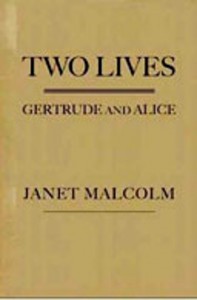 Two Lives: Gertrude and Alice
Two Lives: Gertrude and Alice
by Janet Malcolm
Yale University Press
229 pages, $25.
THIS COLLECTION of three stand-alone essays—not to be confused with Gertrude Stein’s 1936 novel, Three Lives—is a handsomely produced volume with some rarely seen photographs. While portions of these essays were first printed in The New Yorker, Malcolm expands upon those articles here.
How were Stein and Toklas—Americans, Jews, and, oh yes, lesbians—able to live unmolested in occupied France while the war raged all around them and deportations were being carried out at every turn? How did they manage to maintain their pleasant, country life while experiencing few deprivations other than a reduction in the number of their usually lavish meals? How did they survive the billeting of German soldiers at their beloved home? Why did they decide not to escape to Switzerland when they were told that their lives were in imminent danger?
Apparently, their safety was assured by a long-time friend of Stein’s, an anti-Semitic French professor named Bernard Faÿ, who was also gay. Faÿ, who had studied at Harvard, wrote the lengthy preface to Stein’s The Making of Americans (1934). In it, he declares his adoration for both Gertrude Stein and modernist literature in general. Of The Making of Americans, he says that “this gift of Gertrude Stein is the gift of America.” Faÿ translated some of Stein’s books into French, wrote widely on American history in pre-and post-Revolutionary times, and made a reputation for himself as an opponent of the Freemasons. He was frequently quoted in The New York Times in the 1930’s concerning his views on American history. Malcolm stated that he’d been able to “pave the way” for Stein’s 1934 American lecture tour, even teaching her lecturing techniques.
It is shocking and sad to read that Stein was willing to take on the task of translating into English, at Faÿ’s instigation, a book of Vichy leader Marshal Philippe Petain’s speeches. She did, in fact, hold remarkably reactionary opinions and was on the side of the fascists during the Spanish Civil War. When Faÿ was sentenced to life imprisonment for his direct responsibility in the deaths of hundreds of French Freemasons, Alice B. Toklas worked hard (Stein had died in 1946) to get him released from jail, but none of her American or French friends would assist her efforts. He escaped from a prison hospital (possibly, though not certainly, with Toklas’ financial assistance), was later pardoned, and died in the late 1970’s.
While Two Lives has only a few pages of notes and no references or bibliography, Malcolm makes good use of quotations from writers and historians, as well as books written by Stein and Toklas, particularly Wars I Have Seen (which Stein wrote during the Second World War) and The Alice B. Toklas Cook Book. Not mentioned, however, is Stein’s two-act play, Yes Is for a Very Young Man, covering the years 1940–44, which includes a fascinating quotation from Stein (quoted in Carl van Vechten’s introduction to Last Operas and Plays): “I want the audience to realize that French families were divided as our American families were divided in our Civil War and even in our Revolutionary War, and it is complicated and simple, and I hope it will make you feel the French as they really were during the long years of the occupation.”
Herbert Lottman, in The Left Bank (1982), remarked that artists and writers collaborated and resisted almost simultaneously during the War. Stein, despite her collaboration in some respects, also contributed to a resistance magazine. Linda Wagner-Martin, author of Favored Strangers (1995), offers a similarly nuanced perspective, asserting that Yes Is for a Very Young Man shows “obvious evidence of Stein’s familiarity with the resistance.” This area of scholarship is being mined continually: Dartmouth professor Barbara E. Will, for instance, has written articles on the topic in the past few years. She has a work in progress, according to her website, with the working title “Unlikely Collaboration: Gertrude Stein, Bernard Faÿ, and the Vichy Dilemma.”
Malcolm’s two other essays, though no less interesting, are briefer. In her second essay, she tackles the Hersland family—based on the Stein family—in The Making of Americans (1934). “Stein’s own friends [and contemporary book reviewers]felt under no pressure to read the book,” notes Malcolm. She also mentions the elusive and almost mythic scholar Leon Katz, who wrote a dissertation (Columbia, 1963) based on a once-overlooked “cache of small notebooks filled with Stein’s penciled scrawls: notes she had made between 1902 and 1911” and apparently had never shown to anyone, even Toklas herself. Katz found these at Yale, transcribed them, and used them to “decode” the cryptic Making of Americans. He interviewed Toklas near the end of her life—an interview that has never been published.
Malcolm’s writing remains engaging throughout this book. At one point she observes that “Toklas remains the dour ugly crone to Stein’s handsome playful princess. The memoirists who profess to love Toklas … allow their distaste to leak out.” This sums up Part Three of the book, a brief review of Toklas’ post-Stein years of financial struggle—familiar territory to many readers. Like most works of scholarship about Stein, Toklas, and their circle, Malcolm’s tantalizing and all-too-brief essays ultimately raise more questions than they answer.






